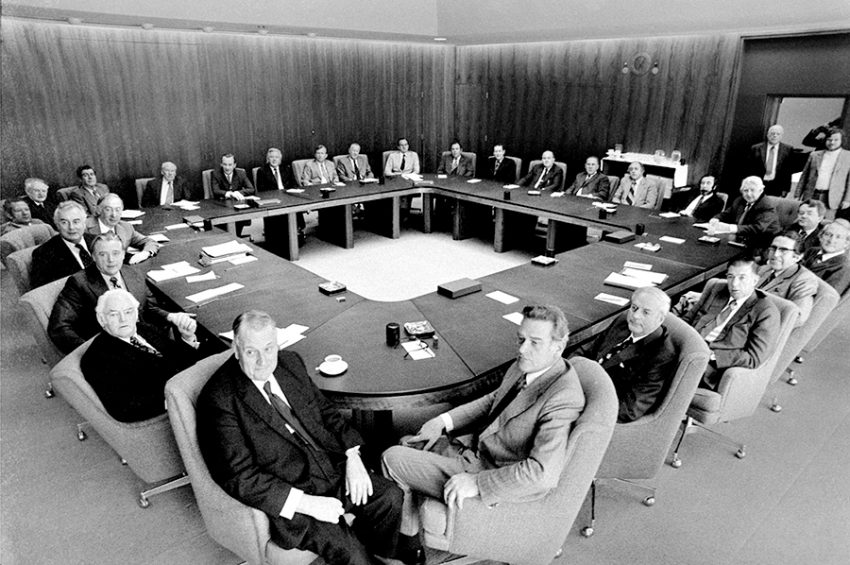
Nobody wants to pay for good foreign policy, but everybody pays for bad foreign policy.
Join that truth to a reality that rules the public service tribes of Canberra: your foes must also be your friends.
The friend–foe fact is formed by a fundamental force of politics and bureaucracy. In Canberra, as in any capital, a dollar can be spent only once. The opportunity-cost law means the government—every day in every way—must choose. What do we really want to pay for? Power and policy push and pull the purse.
While everybody would prefer good foreign policy, they often choose to buy something else. That explains many of the travails of the 50-year journey since November 1970, when External Affairs took on the name Foreign Affairs to serve the new Australia that was emerging for a new era.
The Department of Foreign Affairs and Trade has grown into a great department with an anaemia problem. The anaemia issues are all about Canberra, as the Lowy Institute noted in its 2011 ‘diplomatic disrepair’ study:
DFAT lacks a vocal constituency and has few friends inside Cabinet. DFAT is good at persuading other governments to do things but hopeless at persuading its own government to give it anything like the resources it needs. It needs to employ in Australia some of the skills it uses overseas to knit together coalitions in support of interests.
Sympathy, please, for the pressures DFAT faces in creating Canberra constituency coalitions. The structural forces growing and pressing against the department over those 50 years are formidable.
Tectonic shifts have remade Canberra’s political and bureaucratic mountains, aided by all that has changed in the world beyond Australia:
- the evolution and empowerment of Australia’s presidential prime minister
- the birth of ministerial minders
- public service managerialism
- Canberra’s national security system—and mindset—in the 21st century
- globalisation and the digital era: every government department has its own bit of foreign policy
- political choices: Australia’s two parties of government—the Liberals and Labor—often buy something other than good foreign policy. Plus, important bits of the Liberal Party have an ambivalent view of DFAT fed by ideological hostility.
Top of the list is the evolution of Australia’s ‘presidential’ prime minister, a process of growth and empowerment that’s also about 50 years old. The life of Foreign Affairs has run in parallel with prime ministers becoming presidential, causing profound changes in the department’s ambit and ambitions.
The presidential graft onto Oz politics has many domestic dimensions, but it’s especially strong in the way Australia now does international relations.
Australia’s first modern foreign policy president was Gough Whitlam. To do it himself, Whitlam also served as foreign minister for the first year of his prime ministership (5 December 1972 – 6 November 1973).
When Malcolm Fraser took over as PM in 1975, the international division of the PM’s department was a gentle, small place that worried about the Commonwealth and acted as a post office. Fraser started to build muscle and money by creating the peak intelligence body, the Office of National Assessments, now the Office of National Intelligence.
The bulking and broadening reached a significant peak with John Howard’s creation of the national security committee (NSC) of cabinet in 1996, the same year DFAT moved into its specially built HQ, the R.G. Casey building.
Symbolism and power were moving in different directions. The Casey building expresses DFAT’s place as a great department of state; the NSC points to how money, influence and importance headed elsewhere.
With cabinet’s budget razor gang (the expenditure review committee) the NSC is at the centre of government—so foreign policy still has a seat at the big table. The prime minister chairs the NSC, while the secretary of the PM’s department chairs the secretaries’ committee on national security.
Writing in 2012 about the impact of presidential foreign policy, Michael Wesley commented that the PM’s department exercised ‘much greater influence on the policy-making system, injecting perspectives and preferences, convening and shaping broad policy frameworks, and closely controlling the pace of policy development and ministerial advice’.
Extra presidential steroids went into Canberra’s water in the move from the old to the new parliament building in 1988. In the cramped old parliament, there was no room for a big presidential court. The lines from small ministerial offices to Canberra departments were short and tight. The bureaucracy had a stronger grip than exists today.
Moving into the new parliament allowed the creation of an executive wing at the rear of the building—the Canberra version of the White House West Wing.
DFAT now has long experience of serving a presidential PM. When relations between the prime minister and foreign minister are good, the system can deliver strong results.
Other elements of Canberra’s tectonic shifts, though, have clearly sapped rather than served Foreign Affairs. To be continued …

